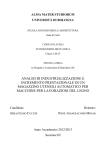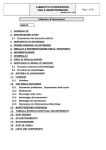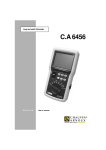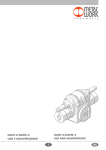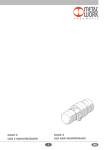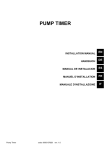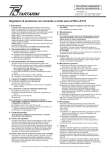Download I GB GPLK USO E MANUTENZIONE GPLK USE AND MAINTENANCE
Transcript
GPLK USE AND MAINTENANCE GPLK USO E MANUTENZIONE I GB CARATTERISTICHE TECNICHE GPLK 1-30 DATI TECNICI Pressione d’esercizio Temperatura d’esercizio Fluido bar MPa psi °C Forza di serraggio di una singola N griffa a 6,3 bar a 20 mm dal piano superiore, in apertura e chiusura Corsa di una singola griffa, regolabile mm Corsa totale massima mm Tempo minimo apertura/chiusura misurato a corsa massima: a 3 bar s a 6 bar s Ripetibilità (su 100 corse a condizioni mm costanti) Momento d’inerzia attorno kg.cm2 all’asse y Peso kg Carichi massimi statici ammissibili Ft N Fa N Mx Nm My Nm Mz Nm GPLK 1-40 GPLK 2-45 SPECIFICATIONS GPLK 2-60 GPLK 2-75 2÷8 0.2 ÷ 0.8 29 ÷ 116 -10 ÷ 80 Aria filtrata 20 µm con o senza lubrificazione. Se si utilizza aria lubrificata la lubrificazione deve essere continua 42 116 1 ÷ 15 30 6 ÷ 20 40 0.18 0.10 0.22 0.12 5.5 ÷ 22.5 13 ÷ 30 20 ÷ 37.5 45 60 75 0.44 0.28 < 0.03 0.60 0.32 < 0.04 0.76 0.36 3.5 4.4 16.4 21.5 29.1 0.44 0.46 1.04 1.12 1.26 7.5 70 9 4 7 15 120 37 23 22 FORZE E MOMENTI GPLK 1-30 TECHNICAL DATA Operating pressure bar MPa psi °C Temperature range Fluid Clamping force of a single jaw at 6.3 bar, 20 mm from the upper surface, on opening and closing Single jaw stroke, adjustable Maximum overall stroke Minimum opening/closing time measured at maximum stroke: at 3 bar at 6 bar Repeatability ((on 100 strokes at constant conditions) Moment of inertia around the y axis Weight Max. admissible static loads Ft Fa Mx My Mz GPLK 1-40 GPLK 2-45 GPLK 2-60 GPLK 2-75 2 to 8 0.2 to 0.8 29 to 116 -10 to 80 20 μm filtered air, lubricated or unlubricated. If lubricated air is used, lubrication must be continuous 42 116 N mm mm 1 to 15 30 s s mm 0.18 0.10 kg.cm2 kg 6 to 20 5.5 to 22.5 13 to 30 20 to 37.5 40 45 60 75 0.22 0.12 0.44 0.28 0.60 0.32 < 0.04 0.76 0.36 3.5 4.4 16.4 21.5 29.1 0.44 0.46 1.04 1.12 1.26 < 0.03 N N Nm Nm Nm 7.5 70 9 4 7 15 120 37 23 22 FORCES AND MOMENTS GPLK-2 GPLK-1 F [N] 160 8 bar 140 120 6.3 bar 100 80 4 bar 60 40 F Ft Fa Mx, My, Mz forza di serraggio / clamping force forza trasversale statica massima / maximum static traverse force forza assiale statica massima / maximum static axial force momenti statici massimi / maximum static moments 0 USO HOW TO USE POSIZIONE DI MONTAGGIO ASSEMBLY POSITION La posizione di montaggio delle pinze GPLK è a piacere. MONTAGGIO Le pinze GPLK vengono fissate al loro contenitore in modo rapido e semplice con il sistema di fissaggio V-Lock. 2 20 2 bar 0 20 40 60 80 100 120 140 160 180 200 220 L [mm] The GPLK grippers can be mounted in any position. ASSEMBLY It is quick and easy to secure the GPLK grippers to their container using the V-Lock system. Se non si utilizzano componenti V-Lock, è possibile fissare le pinze GPLK direttamente con viti e spine. INGRESSI ARIA If V-Lock components are not used, the GPLK grippers can be secured directly with screws and pins. AIR INLETS Si consiglia sempre il montaggio sugli ingressi aria (sia in apertura che in chiusura) di un regolatore di flusso. Come indicato nel disegno sottostante, entrando dal filetto sul lato sinistro si comanda la CHIUSURA della pinza mentre entrando dal lato destro si comanda l’APERTURA della pinza. It is advisable to mount a flow regulator on the air inlets (on opening and closing). As shown in the drawing below, when entering from the thread on the left side, the gripper are CLOSE, conversely when entering from the thread on the right side, the gripper OPEN UP. CHIUSURA pinza / Gripper CLOSING APERTURA pinza / Gripper OPENING REGOLAZIONE DEGLI ARRESTI DI FINECORSA Con le viti 250 e i dadi 260 si fissano le due posizioni estreme “Pinza aperta” (A) e “Pinza chiusa” (B). Procedura di regolazione “Pinza aperta”: • Svitare dado 260 (A); • Aprire la pinza in posizione non soggetta a pressione; • Impostare la posizione di arresto con la vite 250 (A); • Assicurare la posizione di arresto fissando il dado 260 (A). Procedura di regolazione “Pinza chiusa”: • Svitare dado 260 (B); • Chiudere la pinza in posizione non soggetta a pressione; • Impostare la posizione di arresto con la vite 250 (B); • Assicurare la posizione di arresto fissando il dado 260 (B). ADJUSTING THE END-OF-STROKE STOPS The screws 250 and nuts 260 can be used to secure the two “Grippers open” (A) and “Grippers closed” (B) end positions. “Grippers open” adjusting procedure: • Unscrew the nut 260 (A); • Open the grippers in a position not subject to pressure; • Set the stop position using the screw 250 (A); • Secure the stop position by tightening the nut 260 (A). “Grippers closed” adjusting procedure: • Unscrew the nut 260 (B); • Close the grippers in a position not subject to pressure; • Set the stop position using the screw 250 (B); • Secure the stop position by tightening the nut 260 (B). 3 REGOLAZIONE E ALLACCIAMENTO DEI SENSORI INDUTTIVI ADJUSTING AND CONNECTING INDUCTIVE SENSORS Pinza aperta (A) e pinza chiusa (B). I sensori induttivi impiegati devono avere un intervallo di commutazione Sn di 2 mm, e avere un diametro del corpo di 6,5 mm. Procedura di regolazione della pinza con “afferraggio del pezzo dall’esterno”: •Chiudere la pinza (senza pressione) finchè le dita di presa toccano il pezzo; •Regolare l’arresto B (pinza chiusa) in modo che, quando le dita di presa sono in contatto con il pezzo, vi sia una distanza di circa 0,5 mm tra la vite di regolazione e la griffa. •Inserire il sensore induttivo B nella piastra (130) fino a battuta. Se provvisto di LED, quando il sensore è collegato elettricamente, il LED si accende; •Tirare indietro il sensore induttivo, finchè fra esso e la griffa vi è una distanza di circa 1 mm; •Bloccare il sensore induttivo serrando la vite 360 (B); •Inserire il sensore induttivo A nella piastra (130) fino a battuta. Se provvisto di LED, quando il sensore è collegato elettricamente, il LED si accende; •Aprire la pinza fino alla battuta impostata A (senza pressione); •Tirare indietro il sensore induttivo, finchè fra esso e la griffa vi è una distanza di circa 0,5 mm; •Bloccare il sensore induttivo serrando la vite 360 (A). Procedura di regolazione della pinza con “afferraggio del pezzo dall’interno”: •Aprire la pinza (senza pressione) finchè le dita di presa toccano il pezzo; •Regolare l’arresto A (pinza aperta) in modo che, quando le dita di presa sono in contatto con il pezzo, vi sia una distanza di circa 0,5 mm tra la vite di regolazione e la griffa; •Inserire il sensore induttivo A nella piastra (130) fino a battuta. Se provvisto di LED, quando il sensore è allacciato elettricamente, il LED si accende; •Tirare indietro il senosre induttivo, finchè fra esso e la griffa vi è una distanza di circa 1 mm; •Bloccare il il sensore induttivo serrando la vite 360 (A); •Inserire il sensore induttivo B nella piastra (130) fino a battuta. Se provvisto di LED, quando il sensore è collegato elettricamente, il LED si accende; •Chiudere la pinza fino alla battuta impostata B(senza pressione); •Tirare indietro il sensore induttivo, finchè fra esso e la griffa vi è una distanza di circa 0.5 mm; •Bloccare il sensore induttivo serrando la vite 360 (B). Grippers open (A) and grippers closed (B). The inductive sensors used must have a 2 mm switching interval and a body diameter of 6.5 mm. Grippers setting procedure by “clamping the workpiece from the outside”: •Close the grippers (without forcing) until the jaws touch the workpiece; •Adjust stop B (grippers closed) in such a way that when the jaws touch the workpiece the clearance between the setting screw and the jaw is about 0.5 mm. •Insert the inductive sensor B in the plate (130) until it goes. The LED, if provided, comes on when the sensor is powered on; •Pull back the inductive sensor until a clearance of around 1 mm is obtained between it and the jaw; •Lock the inductive sensor in position by tightening the screw 360 (B); •Insert the inductive sensor A in the plate (130) until it goes. The LED, if provided, comes on when the sensor is powered on; •Open the grippers up to the set stop A (without forcing); •Pull back the inductive sensor until a clearance of around 0.5 mm is obtained between it and the jaw; •Lock the inductive sensor in position by tightening the screw 360 (A). Grippers setting procedure by “clamping the workpiece from the inside”: •Open the grippers (without forcing) until the jaws touch the workpiece; •Adjust stop A (gripper open) in such a way that when the jaws touch the workpiece the clearance between the setting screw and the jaw is about 0.5 mm. •Insert the inductive sensor A in the plate (130) until it goes. The LED, if provided, comes on when the sensor is powered on; •Pull back the inductive sensor until a clearance of around 1 mm is obtained between it and the jaw; •Lock the inductive sensor in position by tightening the screw 360 (A); •Insert the inductive sensor B in the plate (130) until it goes. The LED, if provided, comes on when the sensor is powered on; •Close the grippers up to the set stop B (without forcing); •Pull back the inductive sensor until a clearance of around 0.5 mm is obtained between it and the jaw; •Lock the inductive sensor in position by tightening the screw 360 (B). ATTENZIONE: Nelle due posizioni estreme formate dagli arresti A e B le griffe non devono toccare gli interruttori di prossimità 1 (A) o 2 (B). IMPORTANT! In the two end positions identified by stops A and B, the jaws must not touch the proximity switches 1 (A) or 2 (B). La figura sotto mostra la versione con afferraggio del pezzo dall’esterno. The figure below shows the version with clamping of the workpiece from the outside. ~1 130 370 (A) B A B A A B ~0,5 360 (A) Pezzo/Piece 370 (B) 360 (B) ALLACCIAMENTO ELETTRICO DEI SENSORI INDUTTIVI ELECTRICAL CONNECTION OF INDUCTIVE SENSORS DC DC brown NPN Pezzo/Piece 4 www.metalwork.eu black blue Z brown + A 0V PNP + black blue Z A 0V ZPCVK0001 - IM00_06/2014




